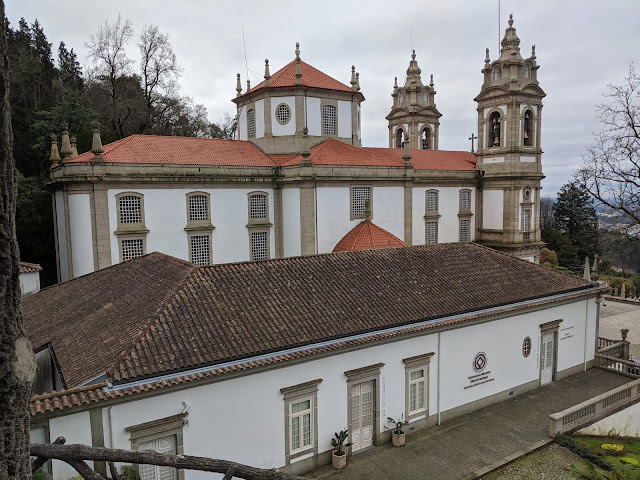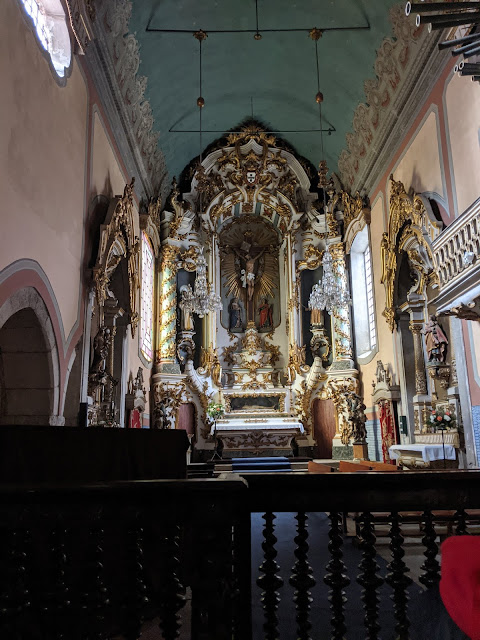Before leaving the HFH Domus, I noticed this large poster with a list of the Portuguese companies that support Habitat for Humanity.
We left the Domus around 9:00 and our bus climbed up a narrow two lane road with multiple switchbacks to get us to the Bom Jesus do Monte or the Good Jesus of the Mountain in Braga.
In addition to the church, there is a hotel and multiple beautiful gardens.
And since are at the top of a mountain, there are great views back down to Braga.
This is a large complex of many buildings including residences and offices for some of the brothers/friars who live and work there.
They have this interesting man made grotto, which we were told hosts many wedding ceremonies.
Did I mention that there were many beautiful gardens and buildings?
We went into the main cathedral.
Among other things, it has an amazing pipe organ.
Our bus took us to the top, but we walked the 581 steps down.
We could have taken the funicular. We were told it the oldest operating funicular that just uses the weight of the water (adjusted based on the number of passengers) in the downward car to pull the other car up.
Here are some of those 581 steps.
The staircases going down create an optical illusion of a chalice in the middle.
We saw the funicular pass by as we descended.
We then took our bus for 30 minutes west to visit the city of Barcelos. Everywhere we went in town, we saw rooster statues.
The main plaza had this interesting sculpture to discourage smoking.
We went inside the small cathedral which is on the main square across from the plaza where they have the farmers market every Thursday - for many hundreds of years. The church is built where the miracle of cross occurred in 1504 and for which it is named.
Again, an amazing pipe organ, as well as a very ornate interior (which was undergoing some restoration work).
We then went to Torra de Porta Nova, or the New Gate Tower of Barcelos - when the walled city existed, this tower protected the entrance to the city. In front of it was a floral clock and inside, many dishes, pottery and sculpture, all celebrating the Rooster as the symbol of Portugal.
We climbed to the top and had excellent views of the old and new city.
We then headed to the archeological museum.
We could see Rio Cavado.
The archeological museum is an open air museum where you can wander throughout to learn about the castle that had been there, as well as the history of the legend which led to the rooster becoming the symbol of Portugal.
The legend of the rooster was on this sign and it is referred to as the Legend of the Senhor de Galo's Cross.
There are four Caminhos do Santiago in Portugal, one along the coast and three inland, so we saw many signs about the camino.
From the museum, we could see across the river to the city of Barcelinhos.
We then took the 35 minute bus ride to Viana do Castelo - at the mouth of the river Limia and on the Atlantic Ocean. We had lunch, then walked by the water front before touring the city. The Gil Eannes is a replica of the hospital ship to care for fishing fleets that sailed the Atlantic from here.
There is a monument called Breaking the Chain to commemorate the uprising of April 25, 1974 that ended the dictatorship in Portugal and led to the transition to a democracy.
As with Porto, Braga and Barcelos, Viana do Castelo is an old city with many narrow streets.
In the old city, we checked out the Hospital Velho, the Old Pilgrims Hospice.
Since Viana do Castelo is on the coast, the coastal Camino do Santiago goes through the city and one of buildings is now a museum to the pilgrims.
Many of the older homes we passed had intricate decorations.
Of course, there is a 15th century cathedral.
We passed by a Lego store and I had to take photos for Ben.
When we got to one of the plazas, they were celebrating Valentines Day. Most of the group visited the Museu do Traje, but a couple of us went for a coffee.
Then we headed back to HFH Domus for a quiet evening of pizza before packing and leaving on Sunday morning.

































































































